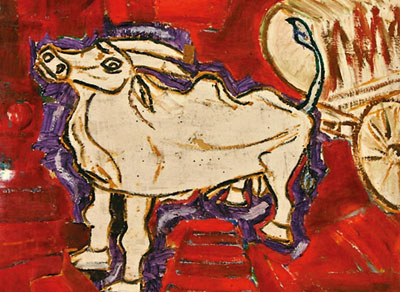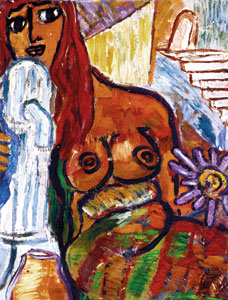I was away when Fareed Uduman's paintings first saw the fluorescence of his posthumous exhibition in 1993, at the Gallery 706 in Colombo. I was then lucky to come across a copy of the book of prints that also include his poems and cartoons.
I look forward to seeing the originals which will be on display at the Lionel Wendt Gallery on January 6 and 7, and if you can also get a copy of the book, you would have got yourself a good deal.
I'm no fey aesthete, nor a scrivener of paintings. Yet I was thrilled to find the portrayals of the book compelling - here is art from everyday life that yet made the familiar seem quite strange, and made you look again and again. The choice and contrast of colours embrace and celebrate the eye. Sober and enchanting are words brought to mind. They are not gaudy like those fabrics made for light- and sun-starved tourists. They do not jar the optical sensibilities. They are not your usual 'abstracts'.
 |
| Cart Bull |
Uduman's very first painting in the album, Cart Bull (Oil on board) shows the now infrequent but still-around kerosene-cart-hauling bull. The cart in the painting appears as a clumsy afterthought, as if the artist forgot to leave space for it, even as its wheel gives an appearance of turning. Yet the bull looks like it is refusing to go anywhere. Its front feet resemble immobile pillars, as if on strike. It even appears to be relieving itself, on the oil cart. And what is most striking is the bull's face, rearing, upwards, and that dramatic and piercing eye.
It's the eye that always make you feel you are looking at another sentient being. Makes you hold your breath, and breathe out through the bull's upturned nostrils. You find this same underlined eye throughout many of the paintings, on people and on birds, an eye that makes you think of other sentient beings, of their lives, of their joys and suffering. The aura painted around the bull makes it appear to be both rearing and shuddering. The only detail missing on the bull from the one that graces our by-roads is the brand scraped into skin, a welt evincing GAS or OIL.
Opposite each painting is either a poem or a cartoon by the artist. I was torn about alternating print and poem, for it sometimes seemed to clash, and at other times compliment, or other times distract.
Yet opposite the first painting Cart Bull, is Uduman's poem, Cattle Led to Slaughter. Read alongside the painting, bull and poem come to life. And the poem, even though about cattle led to slaughter, seems to make the oil bull in the painting more indignant.
Senake Bandaranayake, co-author of Sri Lankan Painting in the 20th Century, calls Uduman's work, "Highly original, sometimes startling and consistently distinctive.... In a society like ours, in transition from a pre-capitalist to a capitalist formation and a dominantly capitalist world, it is difficult to visualize a 'proto-socialist' art or even an art of critique because art must work 'inside' (a cartoon works 'outside'). I think Fareed Uduman must have struggled with this dilemma."
Bandaranayake challenges the view that Uduman's art was a politically charged art while his contemporaries were 'bourgeois'. "It makes sense to combine his paintings and his cartoons. Art can construct alternatives and/or deal with universals... Keyt's work is celebrative of some kind of imaginary world - perhaps one reason why he becomes formulaic in his later years. Justin is a great painter of anguish and tragic irony, Ivan of philosophy, music and calm, and they do it so well. Fareed fails to cross a certain line when we try to combine the 'ideas' of his cartoons with the 'art' of his art. Anyway, in a world like ours, even the most subversive or creative of artists are ultimately captured by the art market, along with a lot of rubbish. I think what we need at the moment is the democratization of the consumption of art."
Yet these paintings were not originally rendered to grace such august venues as the Lionel Wendt and Gallery 706. Uduman made his money, or didn't, as a Hansard reporter. He painted because he wanted to. One can see the humour, the eroticism, the care alongside the carefree and careless, the raw depth, in almost all of the paintings. As his son, Jomo recalls: "He painted on anything he could get his hands on, paintings which ended up being used to replace broken window panes at home." What a lovely image is that?!
Here then are Uduman's windows on urban workers, of carters and of fisherfolk. Woman in Kitchen reminds of the powerful arms of Diego Rivera's paintings of Mexican peasants gathering the harvest. It echoes Brecht's poem, In Praise of Learning:
 |
| Girl by street tap |
"Learn, man in the asylum! / Learn, man in the prison! / Learn, woman in the kitchen! / Learn sixty year olds! / You must take over the leadership. / Seek out the school, you who are homeless! / Acquire knowledge, you who shiver! / You who are hungry, reach for the book: it is a weapon. / You must take over the leadership."
It is also delight of course to see brown faces painted expressively and well in a corporate regimen where only pallid skin is worshipped as beautiful. Uduman's paintings of children's faces are striking in the expression of their innocence, awe and mischief.
Even as women's domestic labour is also portrayed, there is a preponderance of women as objects of desire; still the label of Sneaking Woman may seem unjust, of a painting that could very well be a portrayal of how the less powerful must wield their weapons among the less powerful.
Yet a distinct feature of Uduman's brushwork is of course his unabashed eroticism. Thambilis are not thambilis. Roadside spouts are not roadside spouts. In Orgasm one stretches out languorous with the lover on the rustling, tumultuous sea of her hair. In Goat Lover, one can laugh at the jealousy of a naked Greek-like god who cannot compete with the passionate public abandon of the hooved.
As the writer Stefan Abeysekera reminds: "Uduman's work is above all, honest. Earthy, uncompromising, as much an extension and a celebration of Lanka's soil and sweat as any artist's work. The medium(s) is the message. Painting wherever he could - a great reality and important metaphor for Lankan creativity itself... the street humour cutting through hypocrisy, the wisdom of labor and Eros, it's all there..."
Here are a cluster of paintings to enrich the eye, which like good art makes you see and sense the world better. Here is a book that cuts through the enforced quietude and exaggerated noise- for there is the silence that is not so much silence as it is unnecessary noise. It is meant to flow over what does not fit into a story repeated over and over by the hour. But just as such gloss is completed, the edges of this overly beautiful overlay begin to fray, and worse, the very centre of it erupts into flame. The exhibition and publication of Fareed Uduman's paintings is a simple and wonderful antidote to the silencing of the past. Perhaps this is all not what was intended, yet we have to thank his son Jomo, who put this book out, for presenting Fareed Uduman's work, in all its wonder, warts and all.
The publisher has not tried to hide the politics of the painter. Fareed Uduman supported the liberation of Africa and Asia and the Americas. He was an unabashed supporter of the United Left Front of Srimavo Bandaranaike, and of the Lanka Sama Samaja Party, a communist of that school. The cartoons also give testimony to the underhand methods used to bring down the first strong 'Leftish' government in the country, 1970-77. It is an antidote to the falsehood that Sri Lanka was a 'socialist welfare basket-case' that JR Jayawardene, helped liberate us from.
Here is a testament then that goes against that erasure. It is the only record I have seen in art that does not put down that cusp pre-1977, before Capital decided to wage protracted war again on our people. The cartoons show what lay in store.
The testimonies at the beginning from family are also not smarmy but poignant. The poem Legacy by his granddaughter Dharisha Bastians, describing "Estates spanning half a kingdom / Are not mine to give away," and "I leave you no secure abode," perhaps hints at Uduman's wayward lifestyle, but also his width and depth to "Be anyone's refuge in a storm."
The book as a whole is a gift to a people of an island who are of the whole wide world. |



